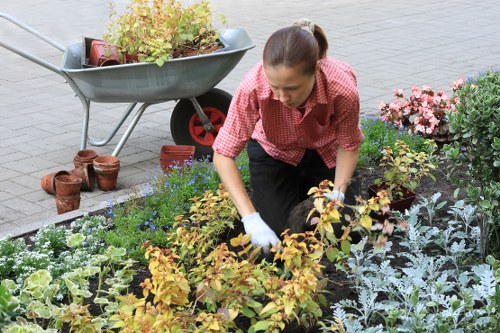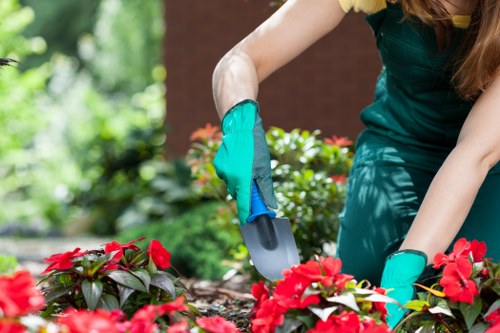Lawn Turf Installation in Lawn Mowing

Transforming your outdoor space begins with a lush, green lawn that not only enhances the beauty of your home but also provides a perfect setting for relaxation and recreation. Lawn turf installation plays a crucial role in achieving this vision, ensuring that your yard remains vibrant and healthy throughout the seasons.
Whether you're a homeowner looking to upgrade your existing lawn or a property manager aiming to maintain pristine grounds, understanding the intricacies of turf installation is essential. This comprehensive guide delves into the benefits, steps, and best practices for successful turf laying, tailored to meet the needs of both novices and seasoned gardeners.
Investing in professional turf installation can save you time and effort, ensuring that your lawn establishes quickly and maintains its beauty with minimal maintenance. Let's explore the various aspects of this vital landscaping service.
The Importance of Professional Lawn Turf Installation

While DIY lawn care projects have their charm, professional turf installation offers unparalleled advantages that can make a significant difference in the long-term health and appearance of your lawn. Here are some key reasons to consider hiring experts for your turf laying needs:
Expert Soil Preparation
One of the critical factors for a thriving lawn is the condition of the soil. Professionals assess and prepare the soil, ensuring it has the right pH balance, texture, and nutrient content. This preparation facilitates proper root growth and water drainage, laying the foundation for a resilient turf.
Efficient Turf Selection
Choosing the appropriate turf type is vital for your specific climate and usage requirements. Experts can recommend varieties that are best suited to withstand local weather conditions, foot traffic, and maintenance preferences, ensuring that your lawn remains lush and healthy.
Precise Turf Laying Techniques
Proper installation techniques, such as correct spacing and alignment of turf rolls, prevent uneven surfaces and promote uniform growth. Professionals have the skills and tools to lay the turf seamlessly, reducing the likelihood of future issues like turf displacement or thinning.
Steps to Successful Lawn Turf Installation

Achieving a flawless lawn begins with following a systematic approach to turf installation. Here's a step-by-step guide to help you understand the process:
1. Assessing the Site
Before installation, evaluate the site for sunlight exposure, soil quality, and any existing vegetation. This assessment helps in selecting the right turf type and identifying any potential challenges that need to be addressed.
2. Soil Preparation
Clear the area of debris, weeds, and old grass. Loosen the soil to a depth of about 6 inches and incorporate organic matter to improve fertility and drainage. Level the surface to ensure an even rollout of the turf.
3. Selecting the Right Turf
Choose turf varieties that match your climate, soil type, and intended use of the lawn. Popular options include Bermuda, Fescue, and Kentucky Bluegrass, each offering unique benefits and aesthetic appeal.
4. Laying the Turf
Begin laying the turf along a straight edge, such as a walkway or driveway. Place each roll tightly against the next, staggering the seams like bricks in a wall. Avoid overlapping and ensure that the grass blades are pointing in the same direction for a uniform look.
5. Watering and Initial Care
Immediately after installation, water the turf thoroughly to help the roots establish in the soil. Maintain consistent moisture levels in the first few weeks, gradually reducing as the turf becomes established.
Choosing the Right Turf Type for Your Lawn

With a multitude of turf varieties available, selecting the right one can be overwhelming. Consider the following popular types to determine which best suits your lawn's needs:
Bermuda Grass
Ideal for warm climates, Bermuda grass thrives in full sun and handles heavy foot traffic, making it perfect for lawns that are frequently used for activities.
Fescue Grass
Fescue is a cool-season grass that remains green throughout the year in temperate regions. It's known for its shade tolerance and dense growth pattern.
Kentucky Bluegrass
Kentucky Bluegrass offers a rich, dark green color and a fine texture. It establishes quickly and recovers well from damage, making it a favorite for residential lawns.
Ryegrass
Ryegrass germinates rapidly, providing quick coverage. It's often used for overseeding and maintaining green lawns during cooler months.
Avoiding Common Turf Installation Mistakes

Even with professional assistance, certain pitfalls can hinder the success of your turf installation. Being aware of these common mistakes can help you ensure a thriving lawn:
1. Inadequate Soil Preparation
Skipping proper soil preparation can lead to poor root establishment and hinder the turf's ability to absorb nutrients and water effectively.
2. Incorrect Turf Selection
Choosing a turf type that doesn't align with your climate or usage needs can result in a lawn that struggles to thrive or requires excessive maintenance.
3. Improper Installation Timing
Installing turf during unfavorable weather conditions, such as extreme heat or cold, can stress the grass and impede its growth. Aim for optimal planting seasons to give your turf the best start.
4. Insufficient Watering
While overwatering can be detrimental, under-watering prevents the turf from rooting properly. Establish a consistent watering schedule to maintain adequate moisture levels.
5. Neglecting Ongoing Maintenance
Post-installation care, including regular mowing, fertilizing, and pest control, is essential for sustaining a healthy lawn. Neglecting these tasks can lead to issues like weed infestation and turf thinning.
Maintenance Tips for a Healthy Lawn

Once your turf is installed, proper maintenance ensures its longevity and vibrancy. Here are some essential tips to keep your lawn in top condition:
Regular Mowing
Maintain your lawn by mowing regularly, removing no more than one-third of the grass height at a time. This practice encourages dense growth and prevents stress on the turf.
Proper Watering
Water your lawn deeply but infrequently to promote deep root growth. Early morning watering reduces evaporation and minimizes the risk of fungal diseases.
Fertilization
Apply a balanced fertilizer tailored to your turf type to supply necessary nutrients. Follow a seasonal schedule to address the lawn's varying needs throughout the year.
Aeration
Periodically aerate your lawn to relieve soil compaction, enhancing water and nutrient absorption. Aeration is especially beneficial for high-traffic areas.
Weed and Pest Control
Implement preventative measures to control weeds and pests, using eco-friendly treatments whenever possible. Promptly addressing infestations maintains the turf's health and appearance.
Benefits of a Well-Maintained Lawn

A healthy, well-maintained lawn offers numerous advantages beyond aesthetic appeal. Consider the following benefits:
- Enhanced Curb Appeal: A green, lush lawn significantly boosts your property's visual attractiveness, making a positive impression on visitors and potential buyers.
- Improved Air Quality: Grass absorbs carbon dioxide and releases oxygen, contributing to cleaner air in your surrounding environment.
- Temperature Regulation: Lawns help cool the air through the process of evapotranspiration, providing a natural air conditioner for your property.
- Erosion Prevention: Grass roots stabilize the soil, reducing the risk of erosion caused by wind and water.
- Recreational Space: A spacious, healthy lawn provides a safe and inviting area for outdoor activities and gatherings.
Cost Considerations for Lawn Turf Installation

Understanding the costs involved in lawn turf installation helps you budget effectively and make informed decisions. Several factors influence the overall expense:
1. Turf Type
The cost varies depending on the turf variety chosen. Premium or specialized grasses may command higher prices due to their superior qualities and performance.
2. Lawn Size
Larger areas require more materials and labor, increasing the total cost. Accurately measuring your lawn ensures precise pricing and minimizes waste.
3. Site Preparation
Extensive soil preparation, including grading, leveling, and amendment, can add to the installation costs. The complexity of the site also plays a role in determining the effort and resources required.
4. Labor Costs
Professional installation services charge based on the expertise and time involved. Hiring experienced landscapers ensures quality workmanship, potentially reducing long-term maintenance costs.
5. Additional Features
Incorporating elements like irrigation systems, edging, or decorative borders can enhance your lawn but may also increase the installation price.
While the initial investment in turf installation can be substantial, the long-term benefits and reduced maintenance efforts often justify the expenditure.
Environmental Considerations

In today's eco-conscious world, sustainable practices in lawn care are increasingly important. Here’s how professional turf installation aligns with environmental stewardship:
Water Efficiency
Modern turf varieties are selected for their drought resistance, reducing the need for excessive watering. Additionally, proper installation techniques enhance water retention and minimize runoff.
Reduced Chemical Usage
Healthy lawns require fewer pesticides and fertilizers when properly installed and maintained. Soil preparation and turf selection can naturally deter pests and promote growth.
Carbon Sequestration
Grass acts as a carbon sink, absorbing carbon dioxide from the atmosphere and helping mitigate climate change impacts.
Biodiversity Support
A diverse lawn can support various insects and microorganisms, contributing to a balanced ecosystem in your yard.
Selecting the Right Professional for Turf Installation

Choosing a reputable and experienced professional is crucial for the success of your turf installation. Consider the following tips when selecting a service provider:
1. Experience and Expertise
Look for companies with a proven track record in turf installation. Experienced professionals are more likely to deliver quality results and handle any challenges that arise.
2. Customer Reviews and Testimonials
Research customer feedback to gauge the company's reliability and quality of service. Positive reviews and satisfied clients are strong indicators of a trustworthy provider.
3. Comprehensive Services
Choose a company that offers a full range of services, including soil testing, turf selection, installation, and maintenance. Comprehensive services ensure consistency and quality throughout the process.
4. Transparent Pricing
Ensure the company provides clear and detailed pricing information, outlining all costs involved. Transparent pricing helps avoid unexpected expenses and facilitates budget planning.
5. Warranty and Guarantees
Reliable providers often offer warranties or satisfaction guarantees, giving you peace of mind and assurance of the quality of their work.
6. Personalized Consultation
A good professional will offer personalized consultations, understanding your specific needs and tailoring their services accordingly.
Conclusion: Invest in Quality Turf Installation for Lasting Results
Achieving a beautiful, resilient lawn starts with professional lawn turf installation. By understanding the benefits, following the proper installation steps, and committing to ongoing maintenance, you can enjoy a vibrant outdoor space that enhances your property's appeal and provides a serene environment for years to come.
Don't wait any longer to transform your yard into the lush, green oasis you've always desired. Contact us today to schedule your turf installation and take the first step towards a gorgeous, well-manicured lawn.